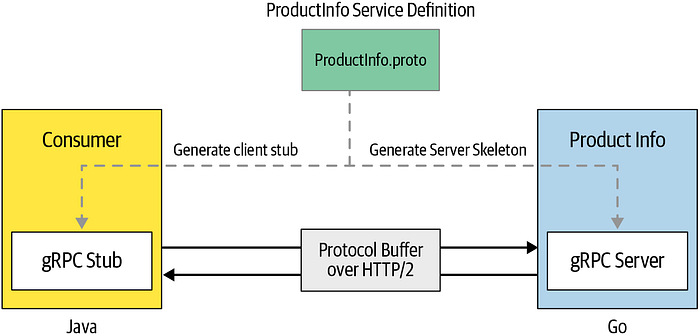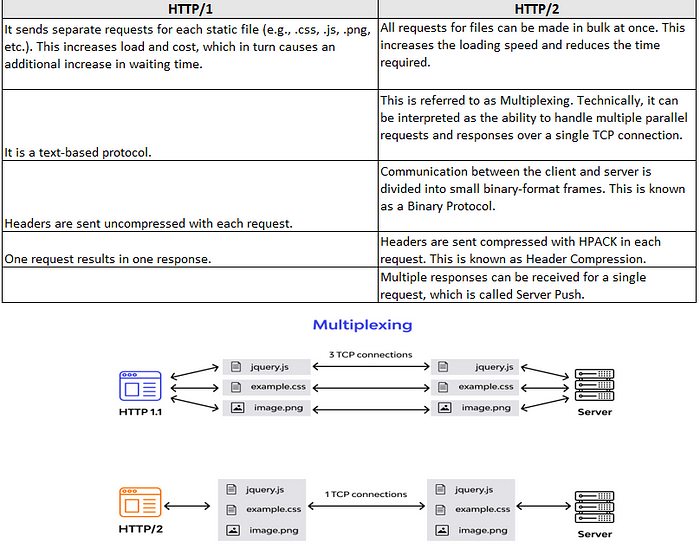Understanding gRPC Services
What is gRPC

gRPC is an open-source RPC (Remote Procedure Call) framework that allows services to communicate with each other efficiently across different environments. The g in gRPC stands for a different word in every version of gRPC which can be seen here. Developed by Google, gRPC leverages the power of HTTP/2, Protocol Buffers (protobuf), and a streamlined approach to client-server communication. Because of that it is essential to know basic concepts of HTTP/2. It can be seen a comparison of HTTP/1 and HTTP/2 protocols below.

At its core, gRPC enables the definition of service methods in a .proto file using Protocol Buffers, which are then used to generate client and server code in various languages, including but not limited to C#, Java, Python, and Go. This makes gRPC a language-agnostic framework that can be used across a diverse set of platforms.
Purpose of gRPC
The primary purpose of gRPC is to provide a high-performance, low-latency communication framework that supports multiple programming languages. Ultimately, RESTful services are generally more suited to being consumed by external clients and, since they are based on text-based messaging, they are not the best option for internal service communication. Therefore, in internal projects that are not consumed by the outside world, using gRPC, which adopts binary-based messaging instead of RESTful, can bring us closer to the speed of communication seen in monolithic architectures.
Key purposes of gRPC include:
- Efficiency: By using HTTP/2 and Protocol Buffers, gRPC is optimized for speed and low bandwidth usage.
- Interoperability: gRPC can be used across various programming languages and platforms, making it ideal for polyglot environments.
- Scalability: gRPC’s design makes it a good fit for systems that require horizontal scaling, such as large distributed systems.
- Ease of Use: The automatic generation of client and server code from
.protofiles reduces boilerplate and simplifies development.
gRPC Concepts and Communication Types Between Client and Server
gRPC offers four different types of communication between the client and server: Unary, Server Streaming, Client Streaming, and Bi-directional Streaming.
Unary -> It is a type of RPC where the client sends a single request to the server and receives a single response back, just like a regular function call.
Server Streaming -> It is a type of RPC where the client sends a single request to the server, and the server starts streaming responses back.
Client Streaming -> It is a type of RPC where the client sends a stream of messages to the server, and the server returns a single response.
Bi-directional Streaming -> It is a type of RPC where the client sends a stream of messages to the server, and the server responds with a stream of messages.

gRPC Advantages
- High Performance: gRPC uses HTTP/2, which allows for multiplexing multiple requests over a single connection, reducing latency and improving throughput. Protocol Buffers, gRPC’s default serialization mechanism, is also highly efficient, contributing to lower network usage and faster message processing.
- Communication Type Flexibility: gRPC supports four types of communication that we mentioned before. This flexibility makes gRPC suitable for real-time applications.
- Cross-Language Support: gRPC’s support for multiple languages allows for seamless integration in environments where different services are written in different languages.
- Strongly Typed Contracts: The use of Protocol Buffers enforces strict typing, which reduces the risk of errors and improves the robustness of the system. The
.protofiles act as a contract between the client and server, ensuring that both sides adhere to the agreed-upon message formats. - Efficient Use of Resources: With HTTP/2, gRPC makes efficient use of network resources by compressing headers, enabling multiplexed streams, and allowing for server push, all of which contribute to better performance in distributed systems.
gRPC Disadvantages
- Complexity: gRPC introduces a level of complexity that may be overkill for simpler applications. The learning curve for Protocol Buffers and the intricacies of HTTP/2 can be steep for developers unfamiliar with these technologies.
- Limited Browser Support: gRPC relies on HTTP/2, which is not fully supported by all browsers. While gRPC-Web exists as a workaround, it adds another layer of complexity and may not offer the same performance benefits as native gRPC.
- Binary Protocol: While Protocol Buffers are efficient, they are also binary, which can make debugging more challenging compared to human-readable formats like JSON or XML.
- Overhead for Simple APIs: For simple CRUD (Create, Read, Update, Delete) operations, gRPC might be overkill compared to simpler REST APIs that use JSON. The setup, tooling, and serialization/deserialization processes in gRPC can introduce unnecessary overhead in such cases.
Conclusion
gRPC is a versatile and high-performance framework that excels in environments where efficiency, strong typing, and cross-language support are paramount. While it comes with some complexities and limitations, its advantages often outweigh these concerns in the right contexts. In the next article, we’ll explore how to implement gRPC in a .NET application, providing you with hands-on experience to see its benefits in action.